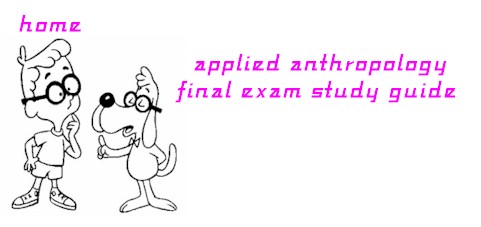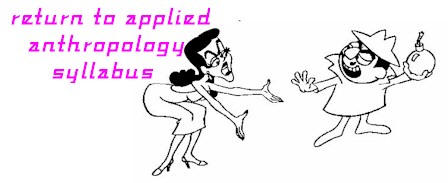
 |
The Final Exam is an open-notes open-book exam: You can use any books, notes, or other materials that you wish. You can discuss your essays with other students in the class, but please plan to write substantively distinct essays. You also can share drafts with me prior to the deadline. The Final Exam is worth 15% of your course grade.
You must email me your final exam by TUESDAY DECEMBER 15. Exams that are received late will be penalized a point each day and receive a zero on December 18. There will not be extensions to the deadline. Any exams that are lost in email transmission will secure my sympathy, but you will not receive credit if you cannot provide confirmation that you did indeed send the exam via email.
You
MUST answer EVERY
ONE of the following essays.
1.
What is collaborative anthropology? Identify
two examples of collaborative anthropology from the semester's guest
lectures: What were the specific
problems the project examined, what parties were collaborators on the project,
and how did collaborative methods provide an especially productive way to
address these issues?
2. Archaeologists
and biological anthropologists are sometimes considered to be outside applied
scholarship. Use two examples
from class (that is, separate lectures and supporting readings) and
indicate how each lecture fit our definition of applied anthropology and
demonstrates some ways that rigorous archaeological and bioanthropological
methods have applied implications.
3.
What does it mean for an anthropologist to be "applied"?
Illustrate your definition with examples from two lectures and their readings
from this semester, and use those examples as illustrations of the key
dimensions of applied anthropology. Outline the practical problems the
research projects addressed and the policy changes (or policy implications) of
that scholarship.
4. The Mayor wants your advice on concrete problems in Indianapolis. Identify one issue that you see or experience in Indianapolis that you think an applied anthropologist should study. Why do you think this issue or problem is important, and specifically what applied anthropological methods do you think would help the Mayor understand the issue and develop concrete solutions for it?
5. After seeing your skills at work with the Mayor, the
Martians have made contact and they are eager to make some changes. They
ask you to provide an anthropological analysis of either the National
Football League, Google,
Chik-fil-A, or Starbucks.
Choose any ONE of those institutions and provide a focused assessment of
the institution’s cultural meanings and roles—for example, what do you
consider the most significant dimensions of this institution, and what (if
anything) can the Martians learn about American if not global lifeways from that
institution? How would an applied
anthropologist study this institution in a distinctive way, and what changes do
you suppose you are going to propose to make?
 |
 |
Last updated November 19, 2015